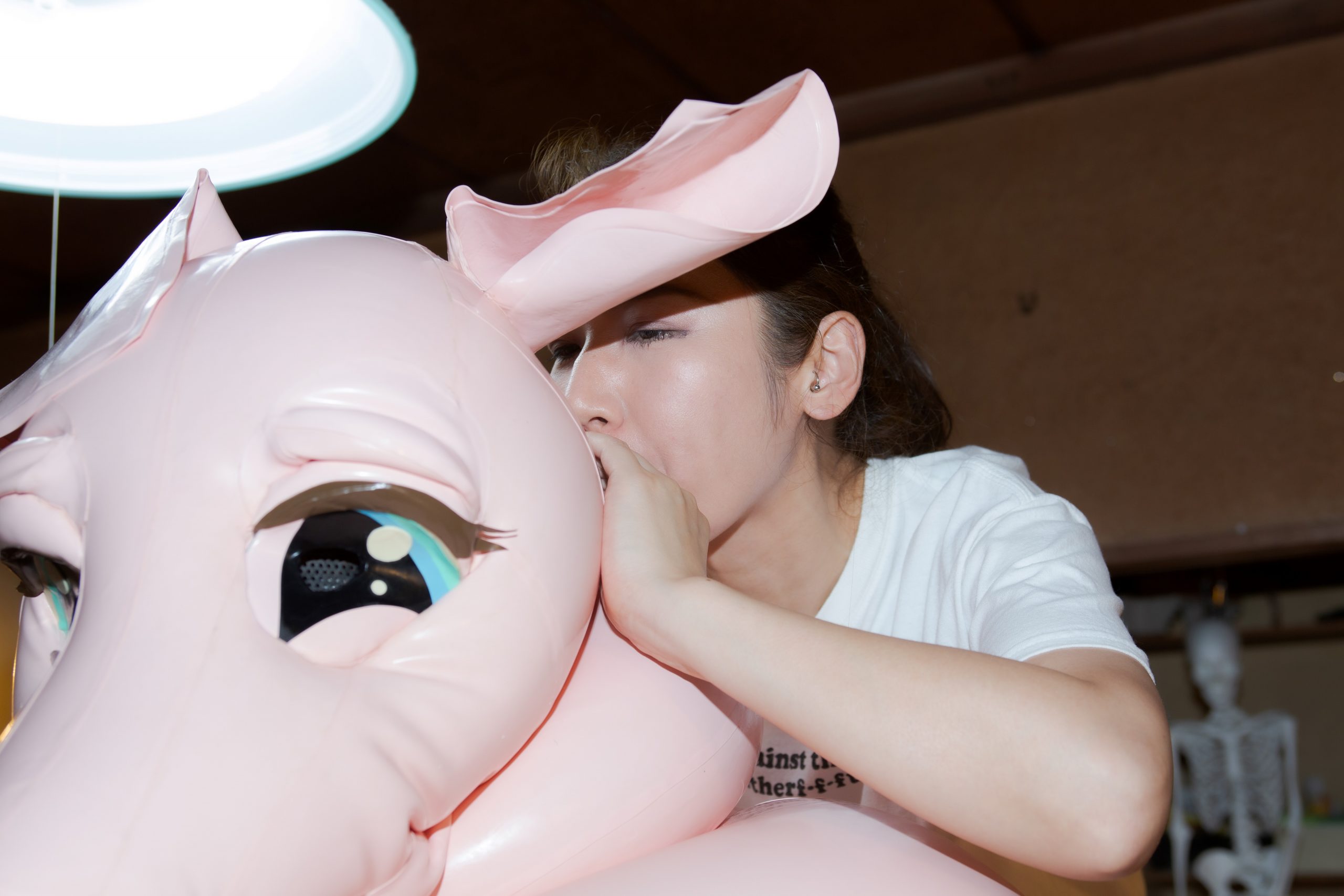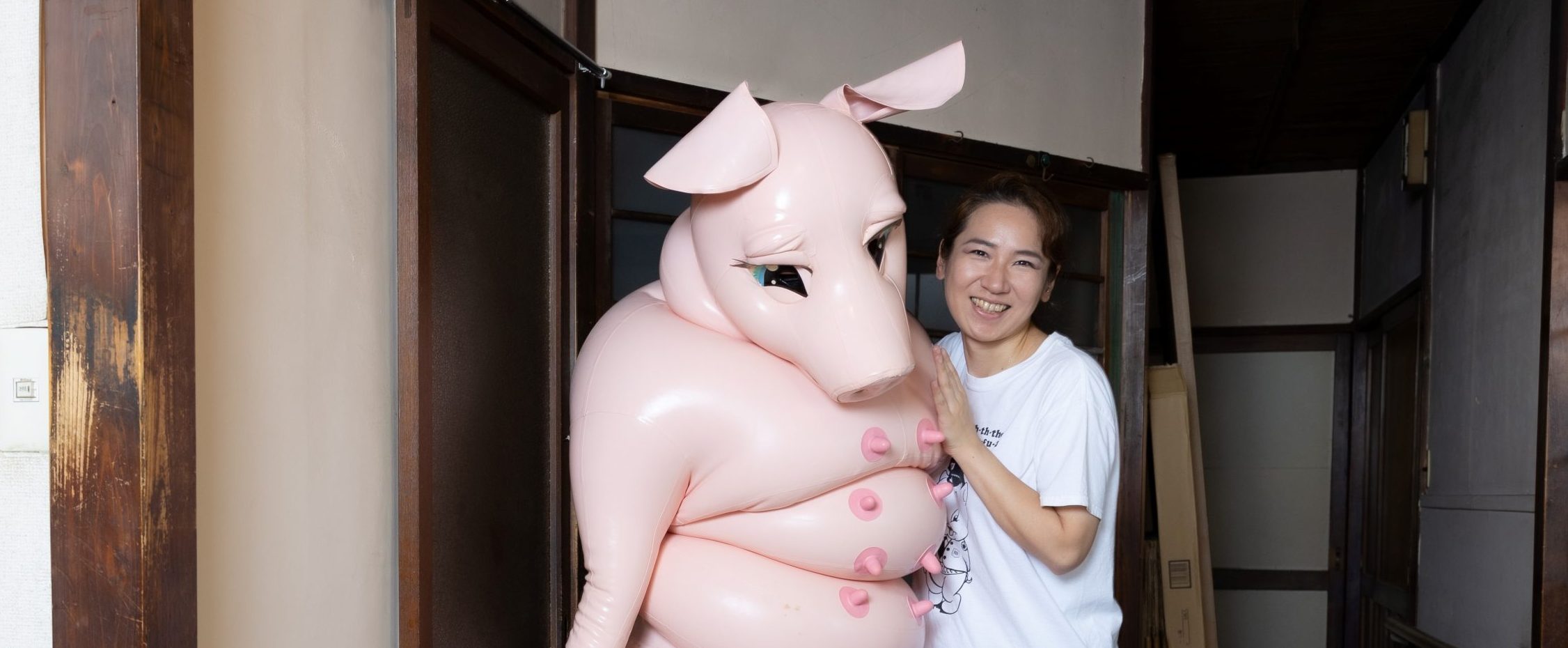
Saeborg
Looking at Humans from Inside a Latex Body + Saeborg Illustrated Guide
Photo: Kikuko Usuyama
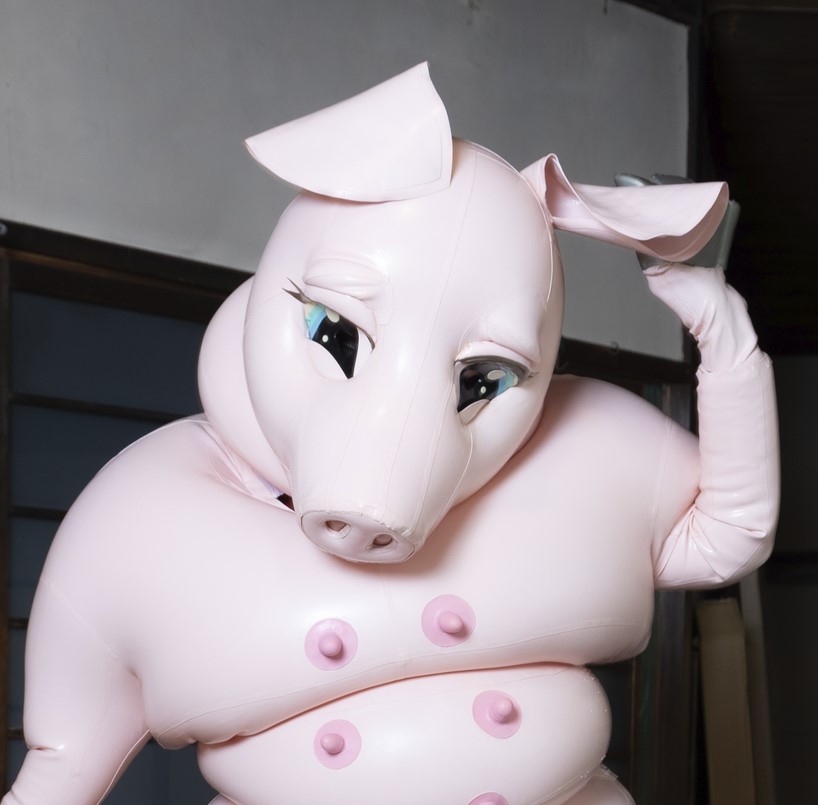
Photo: Kikuko Usuyama
Saeborg
Born in Toyama prefecture in 1981 and graduated from Joshibi University of Art and Design. She creates installations and performances with homemade latex body suits based on themes like livestock and pests. In 2014, she won the Toshiko Okamoto Award at the 17th Taro Okamoto Awards for Contemporary Art, and in 2022 she won a Tokyo Contemporary Art Award 2022-2024. Recent exhibitions and shows include I WAS MADE FOR LOVING YOU at the Tokyo Contemporary Art Award 2022-2024 Exhibition (2024), Pigpen at Middlesborough Art Week (2023), Super Farm at the World Theater Festival (2023), Soultopia at Theater Commons ’23 (2023), Slaughterhouse and Pootopia at Ultra Unreal (2022), solo exhibition LIVESTOCK and more.(Updated November 2024)
Inside a cute, docile female pig suit made of glossy latex is an artist who boldly takes up space and plays wholeheartedly while consciously observing human behavior.
Saeborg, who calls herself an “imperfect cyborg that is half-human and half-toy,” conjures up pop, amusement park-like spaces modeled on the living environments of animals born to serve humans such as livestock and pets. Viewers are not restricted to being onlookers but are welcomed into the space in a friendly manner, where they gradually become aware of the reality of the human position and activity in the ecosystem.
Her art that began as cosplay at an underground fetish party gained support from enthusiasts of many stripes and went on to be interpreted through urgent global themes like gender and diversity, animal welfare and meat-eating/vegetarianism, religious issues, environmental destruction, ecological movements and more, and now she experiences constant requests from around the world for exhibitions and performances. As diverse empathy and understanding for her work grows, what is Saeborg herself aiming to do? Here’s a look at what she’s done from the start to the present, and an
introduction to her regular cast of characters.
Interview/text: Rieko Suzuki
English translation: Claire Tanaka
How did a student who was into toys and doujinshi (fan-created or self-published print works, often erotic manga) become Saeborg? Can you start off, as an introduction, by talking about the early history of the artist that is Saeborg?- I am and have always been a fujoshi.1 For example, I think people who are into yaoi2 don’t like their role as women so they turn their attention to man-on-man action.
In my case as well, for ages I have strongly wanted to quit my role as a woman. Even if I saw a character I liked and thought, “Cool! I want to be like him.” I have never thought that I wanted to be a girlfriend or his lover. I think that’s why I began creating things to ridicule gender roles, like female livestock that no ordinary person would ever get turned on by. It started with an urge to drop out of that sort of framework.
- When did you settle on this way of expressing your doubts about gender, through wearing a body suit and performing as a human-yet-not-human?
- I moved to Tokyo from Toyama prefecture and joined the painting department at Joshibi (Joshibi University of Art and Desigin), but there are tons of people who are partial to paintings, and I was struggling as I didn’t know how to utilize my skills. At that same time, I was attending a regular fetish party called Department H3 and enjoying costume play, but I never thought that it could connect to my own personal mode of expression. But one day, my seminar teacher who still helps me out a lot, told me, “Sae, you put on rubber and go to that party as a matter of course, but you can’t put on a solo exhibition as a matter of course. Isn’t that an insult to Department H?” I realized that was true, and that while I was putting all my energy into making rubber body suits, I somehow separated that from my position as an artist. That was when I began to realize that I could present what I was doing naturally as a form of art.
-

Photo: Kikuko Usuyama
Was that when you began going by Saeborg?- At Department H, everyone goes by fanciful party names, so I thought it would be cool to use part of my real name, Saeko, and combine it with something like Cyborg 009,4 and that’s where I got my name. I also had this image of an old transforming cyborg toy where you could add and remove items. The idea is to see even my own body as something plastic and reconfigurable. It’s the same sensation as playing with a toy. I wasn’t able to become a rich toy collector, so I thought if I made my own toys that I could wear and perform in, I could make my own playland. I think my debut as a so-called artist was at the Taro Awards in 2014 (17th Okamoto Taro Contemporary Art Awards, winning the Toshiko Okamoto Award), but at that time the name I used in underground parties was already known, so I decided to use Saeborg for my art.
-
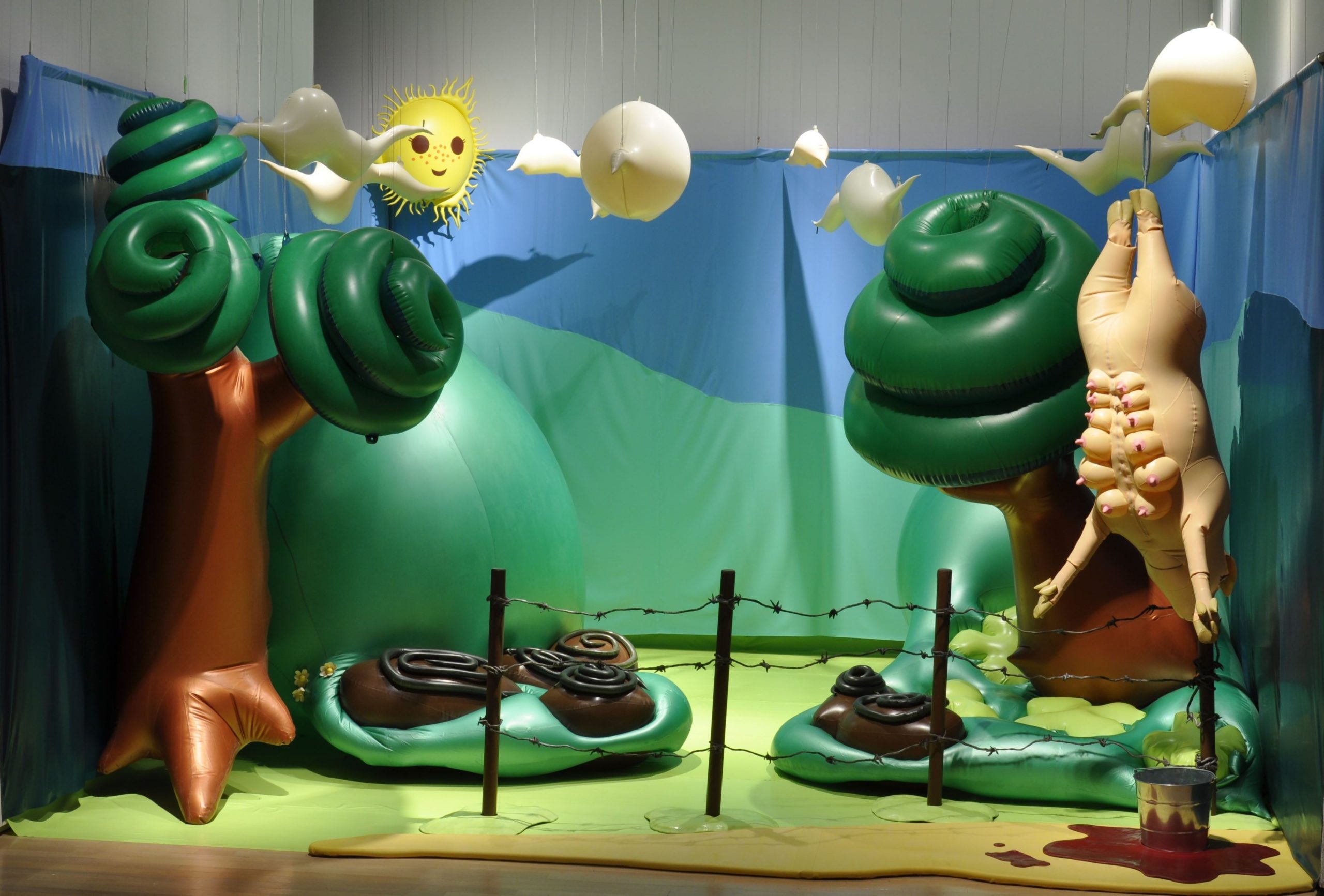
“The 17th Taro Okamoto Award Exhibition” Slaugterhouse-9
Photo courtesy of Taro Okamoto Museum of Art, Kawasaki, Kanagawa, 2014
-
Fujoshi
A type of female otaku who is specifically interested in content depicting romance and sex between men.
-
Yaoi
A generic term for content created for women that depicts romance and sex between men.
-
Department H
A unique underground event held the first Saturday of each month at Tokyo Kinema Club in Uguisudani, Tokyo. It features performances and costumes based on fetish themes like rubber, leather, gothic, drag, S&M, and more.
-
Cyborg 009 (zero-zero-nine)
A popular manga series created by Shotaro Ishinomori (1938-1998). It depicts nine cyborg soldiers all called by numbers beginning with 00. Since 1964, when Shukan Shonen King began serializing the manga, it has become widespread in manga, tv animation, and movies over a half century. Incidentally, the origin of the nine cyborgs is 001: Russia, 002: USA, 003: France, 004: (Former) East Germany, 005: North American Indigenous, 006: China, 007: UK, 008: Africa, and 009: Japan.
-

Saebeef Photo: Taro Irei
You began your Livestock series around 2009, with the Saebeef cow.- My first non-readymade wearable was a catfish, and next was Sex Poodle. Those I designed myself and paid a latex brand called Kurage to make them. After that, I began making everything myself. First, I made an alien for practice, and from then on I began making animals and that continues to the present. When you think of making costumes of latex, most people think of cat suits, but ultimately those are in the shape of humans, right? Even if it feels different, the form is the same. The body type you were born with becomes the focus, and I never thought my body type or my shape was interesting, so that wasn’t for me. I’m interested in distorted shapes, and I love to think about how something can be far removed from the human body while still having a human inside. I began with a cow, and went on to make sheep, chickens, farmers, farms, pigs walking on two legs, and pigs walking on four legs. At first, I was happy with any sort of animal, but the organizer of Department H, Gogh Imaizumi, said “You should make this into a Livestock series. That’s perfect for your tastes.” And I thought, “That is true.” People who come to these parties come in uniforms that reflect their fantasies. That’s why I wanted to focus on weak things. “I am the weakest, but I am the queen,” is the feeling. Many people who do costume play attach horns and like to go in the direction of a strong, attractive image, but I didn’t want to do that.
- The work you did that won the Toshiko Okamoto Award was Slaughterhouse-9, part of your Slaughterhouse series that depicts female pigs and other livestock in their ordinary environment. In addition to the animal, there is also a sun, trees, and a whole ranch built from rubber, and you put on shows featuring sheep shearing and pig slaughtering. The sense of having stumbled into the colorful and poppy world of Playmobil and the grotesque reality it coexists with creates a strong impact.
- In such a bright and fun-seeming place, they’re being managed without their knowledge, which is cruel, isn’t it? I tell the performers not to act sad, but to just do it in a carefree way. I don’t give much concrete direction. The only things that I decide are when to come out, where to be cut, and to fall over. That’s because the characters already have stories behind them. They get shorn and their breasts pop out, they lay eggs, they get slaughtered and made into ham. They’re each given a role and a fate, and the theme comes across simply by showing that.
- I think the theme of livestock highlights the roles and exploitation that are built into society as a matter of course. It’s a theme that also connects to issues like animal welfare and environmental protection.
- I didn’t think about it too deeply, but simply chose livestock as a theme because they’re weak and managed. But after getting and seeing people’s reactions, one thing I felt was that livestock are like a mirror for us. Some people say my work is deep, but I’m not deep, it’s the livestock. I think it’s because animals have been partners with humans for such a long history that they are able to show us so many themes.
- Since House of L, which was unveiled at the Aichi Triennale 2019, your interest in animals has expanded to pets.
- I had always had a cat, so I wanted to do a pet series from fairly early on. Pets are strongly connected to issues of domestic violence, and their close connections with humans give them an even more brutal side. But if I started out using pets, I felt like people would simply consume it as cute content, so I decided to carry on with the Livestock series for some time before I did it.
I consider the control of reproduction the definition of livestock, so pets are also livestock, but if I can’t explain that properly the cruelty doesn’t come across. That’s where I thought up the dog that appears in House of L, a huge, ugly pet that spews vomit. I combined this ugly pet with the characters I had made with my Livestock series, and in the piece, the audience played by giving milk to the baby pigs and also interacted with this dog that was a clumsy and incomplete presence, unsuccessful at being a cute pet. The audience had fun, and it was a warm, friendly atmosphere like a preschool, but for me I felt like the pet theme hadn’t been fully explored, so I went on to create I WAS MADE FOR LOVING YOU at the Museum of Contemporary Art Tokyo.
-

Saedog, “I WAS MADE FOR LOVING YOU” , 2024 Photo: TAKAHASHI Kenji
- I WAS MADE FOR LOVING YOU was unveiled at the Tokyo Contemporary Art Award 2022-2024 Exhibition. In the middle of a large space with a backdrop depicting a farm, there’s a platform with a single dog sitting on it. People who come in spend a moment interacting with the Saedog that sheds tears, trembling in fear at the humans.
For this exhibit, along with other performers, you personally also took a turn at being the so-called ‘internal organs’, acting as Saedog. How was your experience as Saedog? - A lot of people cried. I went to them like, “don’t cry” and tried to comfort them. When I was able to be with the visitors, I felt that the dog had fulfilled its role as I wanted to care for lonely people after all. However, sitting on all fours and becoming a spectacle acting like a dog, I naturally became fearful of humans. People interact in different ways, and they have both a gentle side and a nasty side, so it brought out the nasty side in some and I got hurt. There is a horror in becoming a spectacle, and I began to fear having my picture taken by cameras and smartphones at close range. I did expect it, but it was even more frightening than I anticipated. But I was also surprised that there were more kind people than I thought.
- Saedog doesn’t just draw out the spirit of care in people who face weakness, it also becomes a friend with whom to share weakness and heal others’ loneliness.
- By making a performance with a body suit that invites pity, it’s possible to move people emotionally. I think that moment of reversal is interesting. Saedog also has moments when it is like a priest. It listens to people’s worries and comforts them. I wonder what that is… if you read dog backwards it spells god, and although it might be too much to say it’s like Christ, but it does give energy to people. I like that dynamism of change.
- With this work, the main focus was about time spent facing the audience head-on, and in Super Farm that was performed at the 2023 Theater der Welt (Theater of the World) in Germany, audience members participated by putting on their own animal ears, noses and so on. Your works have always been based on the premise of performing in costume, but in recent years it seems like the way you build relationships with the audience is expanding.
- When I was invited to the Aichi Triennale, director Chiaki Soma introduced me to a lot of people and invited me to workshops in order to help me develop a common understanding, and from those experiences I came to acquire words inside myself for this awareness of what you might call choreographing the audience. This is also thanks to Sebastian Kawanami-Breu, who participated in House of L as dramaturg. Also, Department H is a salon with communication at its core, so even if the show exists as a template, it is also part of something that is shared with party participants, and each person’s own peak moment is different.
Regarding the interactions with audiences, there’s something I’ve been aware of since that time. But the choreography is just a framework created by the organizer. So if it were me, how would I make a party? Now I use my newly acquired concept of choreography and I feel like I am reassembling it in order to change myself and change what sort of experience I will have audiences take home.
-

For Super Farm in 2023 at the Theater der Welt in Germany, audience members were invited to choose animal ears and tails in the lobby and wear them in the show.
-
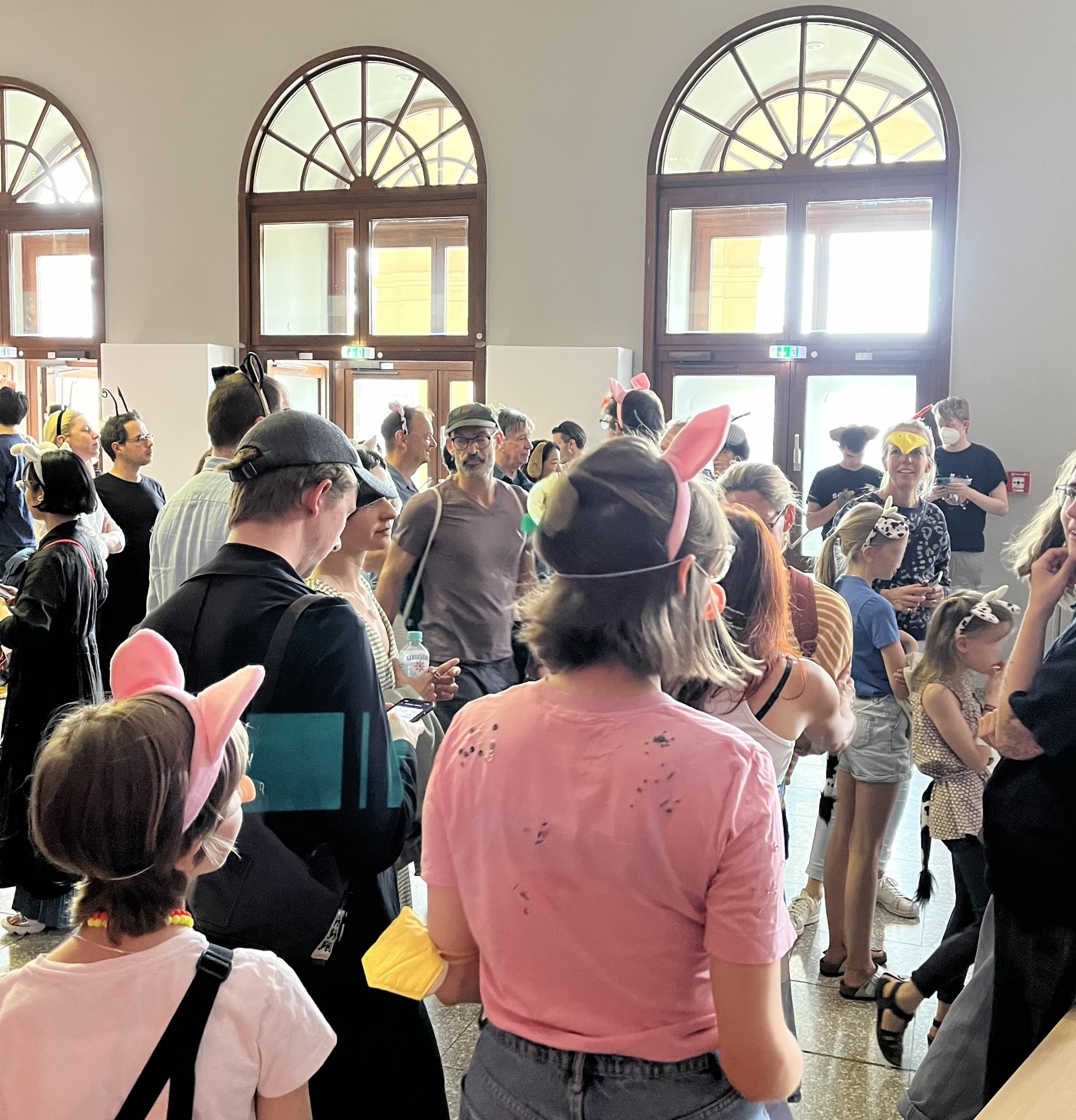
- Your starting point for using latex suits was to focus on the plasticity and expandability of the body, but at Theater Commons Tokyo ’23 you also worked on Soultopia which was a VR work that had no physical bodies at all.
- Once I began playing with the VR, I found that the sensation was surprisingly similar to the body suits. The headsets are heavy to wear and tiring, and it changes your perspective, so it’s a surprisingly physical experience. There’s also a high degree of customizability, so I can understand how people who like body suits also get hooked on personal avatars.
- Players become tapeworms and travel through a cow’s intestine, are excreted, die, and are resurrected in this ranch world. During this time there are interactions between players, and the work gives a sense of euphoria not felt in previous works.
- I wanted to do something that totally wasn’t possible in the real world, something I couldn’t do with real-life body suit design. I also thought about how participants could interact and communicate with each other. I actually participated myself as well, and when it ended, I felt like my soul had left my body. I wanted to make a reincarnation experience where the experience of returning to reality was the beginning of another reincarnation, using the Soultopia world to detox and bring memories of that special gentle feeling of everyone helping each other back to the real world. When people removed the headset, I wanted them to have the feeling of having been reborn into the real world. I was hoping people would feel refreshed by it.
There are a lot of things in that world that we can’t do in real life, but there is gravity, and all kinds of limitations, and it’s not completely a fictional dream world. I was going for this idea of it being another reality. It’s a world made up and designed by people, so I feel like the idea is similar to how design for communication on social media is made. It’s like exploring a new village (community) in cyberspace.
- I think VR and online works that people can experience without physically moving will become more appealing in the future. How will you deal with this trend?
- It’s easier to use VR to create something that’s in my head, and you can change the lighting with a tweak of the settings, and I suppose it’s easy to design as well. But because it’s easy to do a lot of things, the design isn’t necessarily well thought-out. I think the creativity I use to work within the constraints of reality is a positive addition to my body suits, and above all, I really gain a lot by going to real places to do my performances.
In a place like metaverse you might happen to get to know somebody, but the volume of information available in real-life places and people far exceeds that. In other words, the encounters that happen simply by going to a different environment, and what becomes visible by changing perspectives is a fun experience in itself.
If I can’t have interesting experiences in real life, I can’t bring those online, so in that sense I will just have to keep pushing forward in my own way.
-
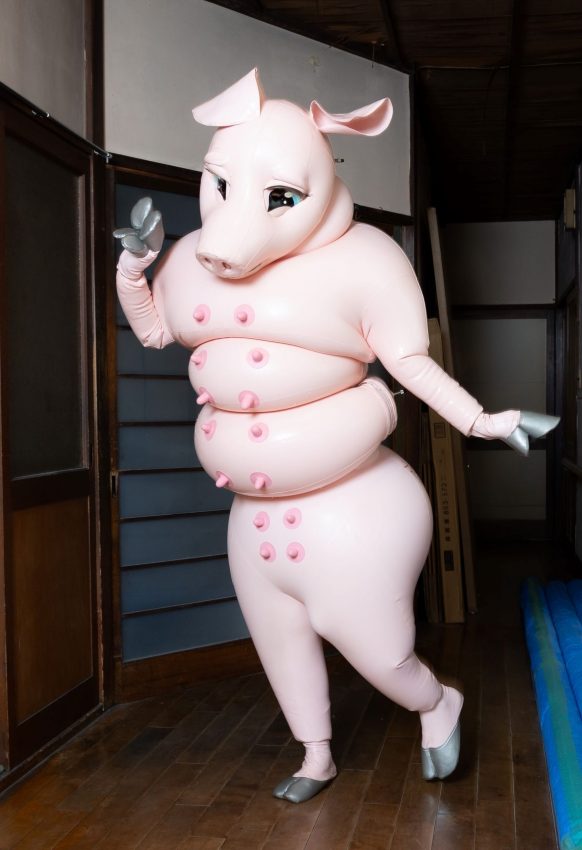
Saeborg’s signature character, Saepork. On the date of this interview, the ‘internal organs’ were body suit artist and actor Tae Tsuyuki. The moment the calm, quiet woman donned the pork, she transformed into a charming and coquettish presence. Photo: Kikuko Usuyama
Saeborg’s Illustrated Guide
Wear one of these handmade latex body suits and a half-human, half-toy Saeborg appears. What do these weak creatures who swear allegiance to human society hide beneath their cute exteriors? Here’s a short introduction to the residents that make up the Saeborg world, with each character’s role and story. (production year/material)
1. Sex Poodle (2008/latex)
“I thought it would be cool if I could have both male and female at once. I chose a poodle with the idea that it’s the sort of pet that Barbie has. Even if you make them look glamorous, ultimately they’re still animals.”
-
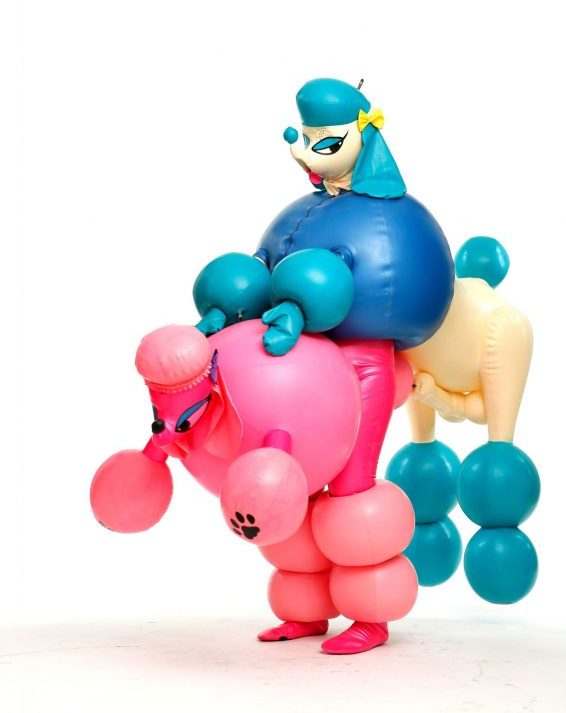
Photo: ZIGEN
2. Saebeef (2009/latex)
A dairy cow. It’s kept pregnant to ensure milk production. “I was influenced by Teletubbies, a children’s program on the BBC. Those characters are cute, but sometimes there’s this voice that comes from somewhere saying, ‘Time to eat.’ It made me think, ‘Ah, there’s a caretaker.’ They look like they’re having fun, but they’re not there of their own free will.”
-
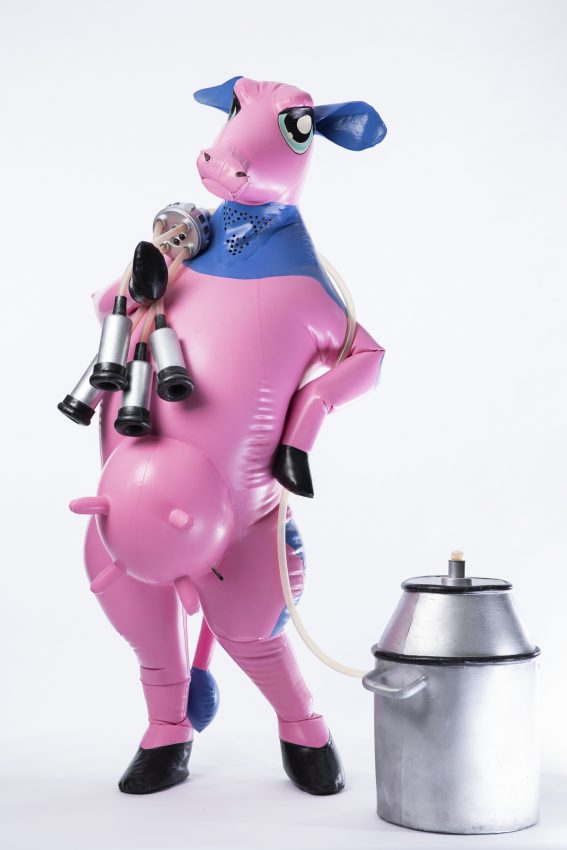
Photo: Taro Irei
3. Saesheep (2010/latex)
A sheep. It regularly gets shorn, causing it to become nude. “I think wool is usually expressed by combining it into a three-dimensional shape, but I figured it would be faster to draw spirals in a comic style. This one is the second generation, with a more powerful look than the first one which was chocolate brown and light blue.”
-
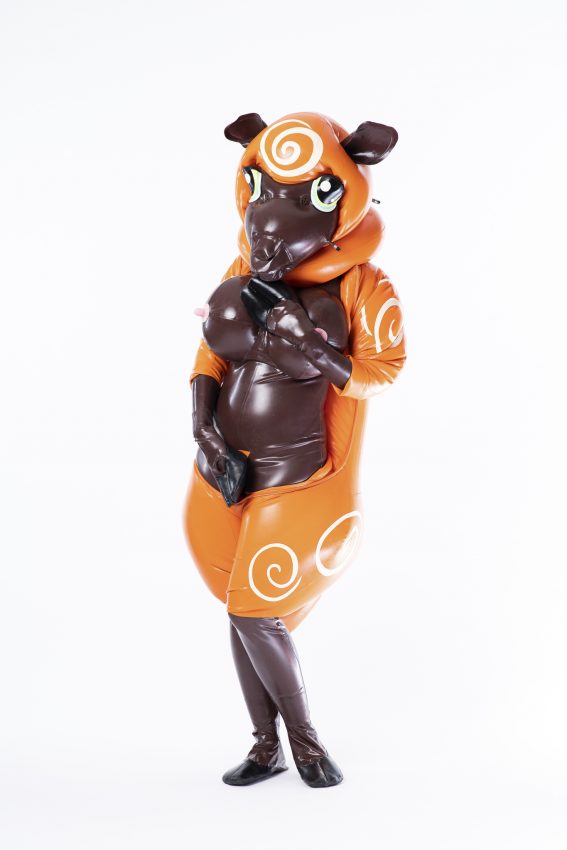
Photo: Taro Irei
4. Saenofu (Farmer) (2011/latex)
Farmer. A female just like the livestock. Remove her clothing and the control number engraved on her is exposed. “I was inspired by Playmobil. I made it to be an assistant for the livestock, but when I tried it on, it was so hard and I couldn’t support the others enough. She’s meant to be a sort of stagehand so it’s a bit part, but a lot of people like the farmer. I guess humans can’t help but being attracted to other humans.”
-
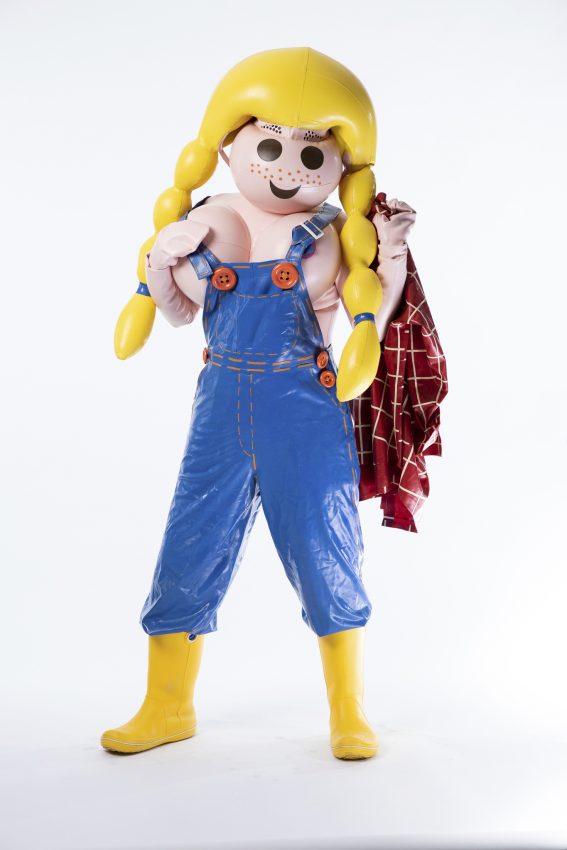
Photo: Taro Irei
5. Saechicken (2012/latex)
A hen. It continuously lays eggs. “When you get inside, it’s made so your face is on the butt side. The green and orange coloring around the face is inspired by Kellogg’s (the cornflake brand). When it lays eggs, the audience always cheers it on, saying, ‘You can do it’ which I think is great.”
-
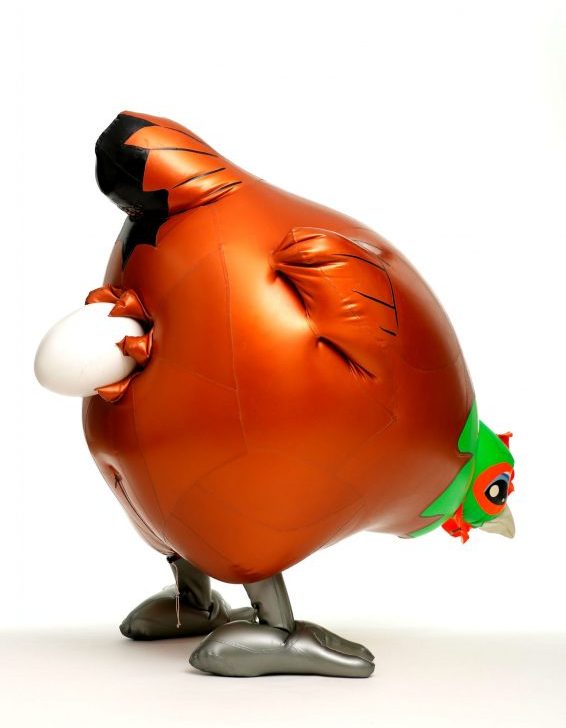
Photo: ZIGEN
6. Saepork (2013/latex)
Female pig. It lives to provide good quality pork. “The important thing is you can take meat off it. People often call it a ‘living sculpture’ but the difference between a sculpture and a body suit is whether there’s someone inside or not. When you peel off the flesh, you can see the body inside, and it feels alive. That’s what makes it more interesting than just the message about meat.
-
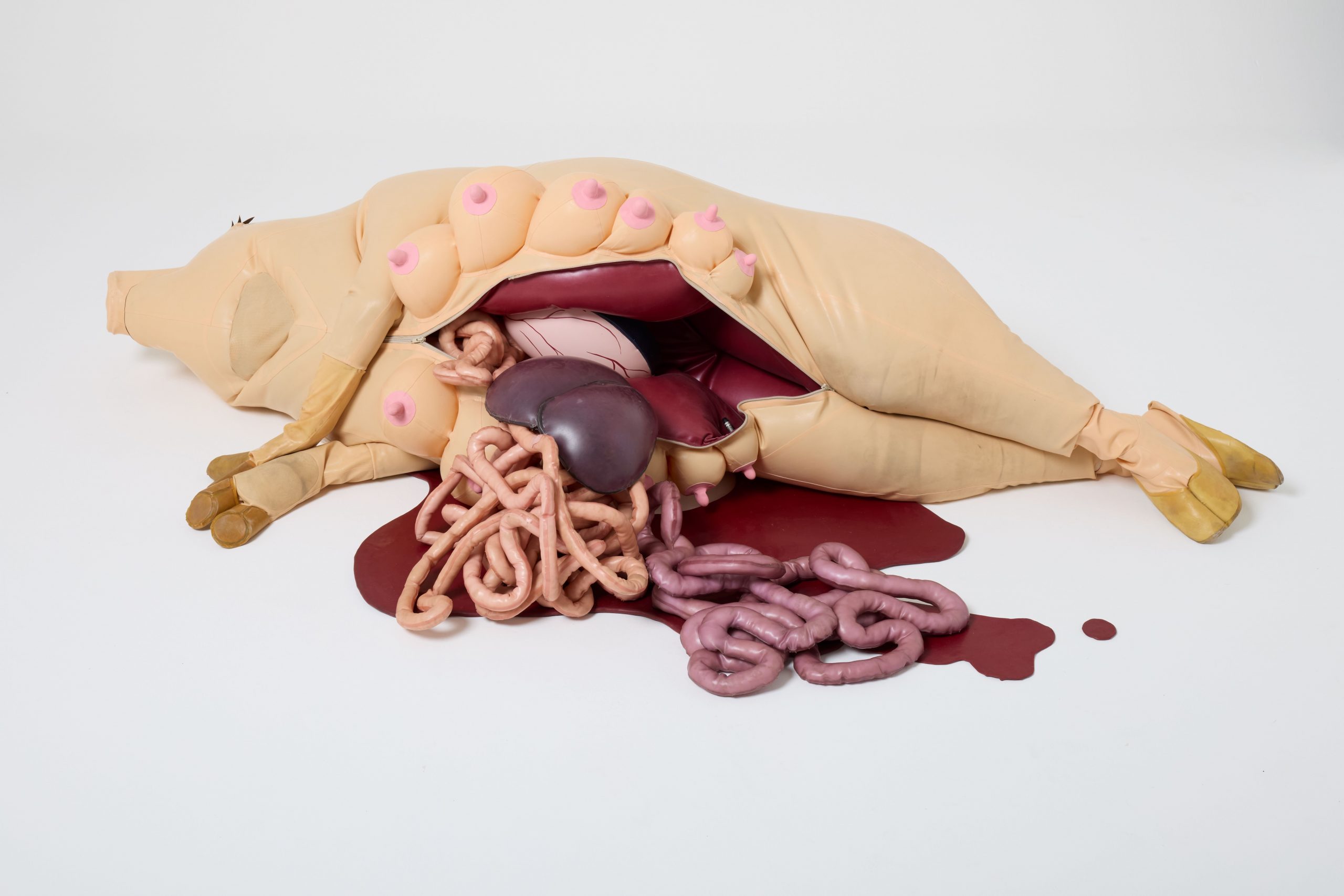
Saepork type 2 Photo: TAKAHASHI Kenji
7. Poorincess (2018/latex)
A princess dung beetle that lives in a palace of poo. “I made the body suit version with a sort of hat, but the real one has a shovel-like protrusion on its head that it uses to dig in the dirt. The shape looks like the sun and it is called ‘the incarnation of the sun.’ She’s a low-class character that eats poo, but she’s actually very important.”
-
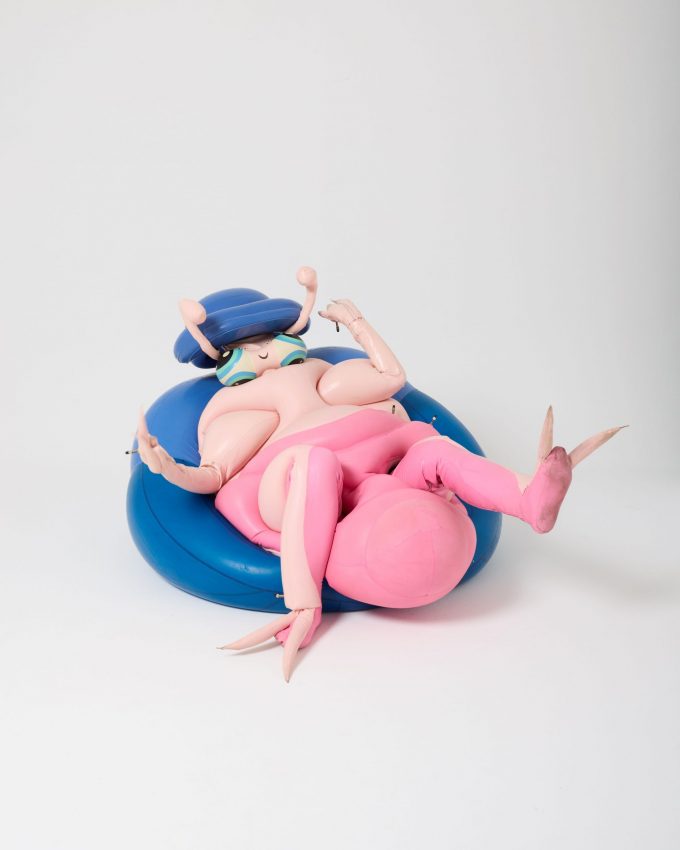
Photo: TAKAHASHI Kenji
8. Poo and Flies (2018/latex)
Dog poo and its accompanying flies. “I took a long time to consider the shape of poo. One day, a friend said, ‘everything is a spiral’ and I rotated it. Just by twisting it resulted in a wonderful shape. The flies are there as part of the set because if you go to the farm, you can hear the sound of their wings the whole time. They are also an important part of expressing the rich aroma of the poo.”
-
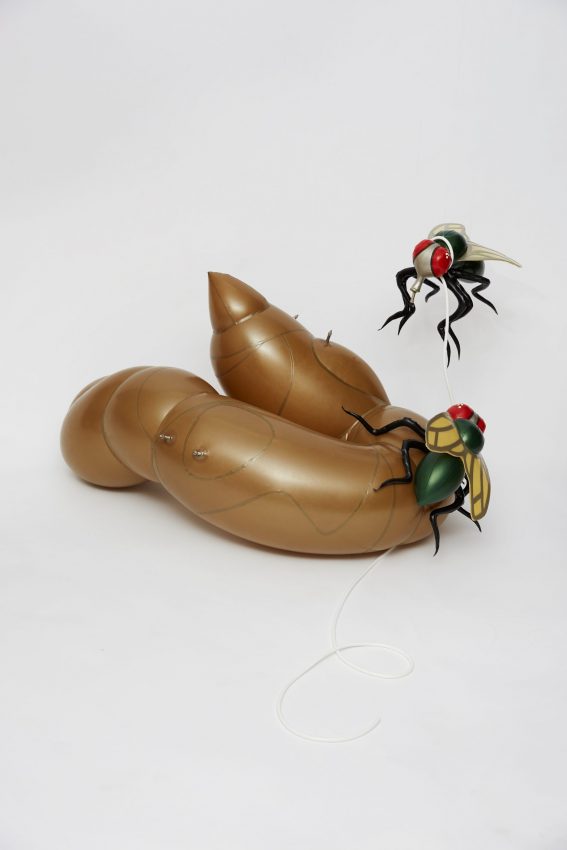
Photo: Charlie Engman
9. Ant (2020/latex)
A caretaker for Poorincess. “I also made this as a stagehand. It’s possible to put it on alone, and it’s easy to move. The other body suits can’t be worn alone, and they’re not independent. This is one form of care, and I actually thought of it as something enriching, but this ended with the COVID-19 pandemic.”
-
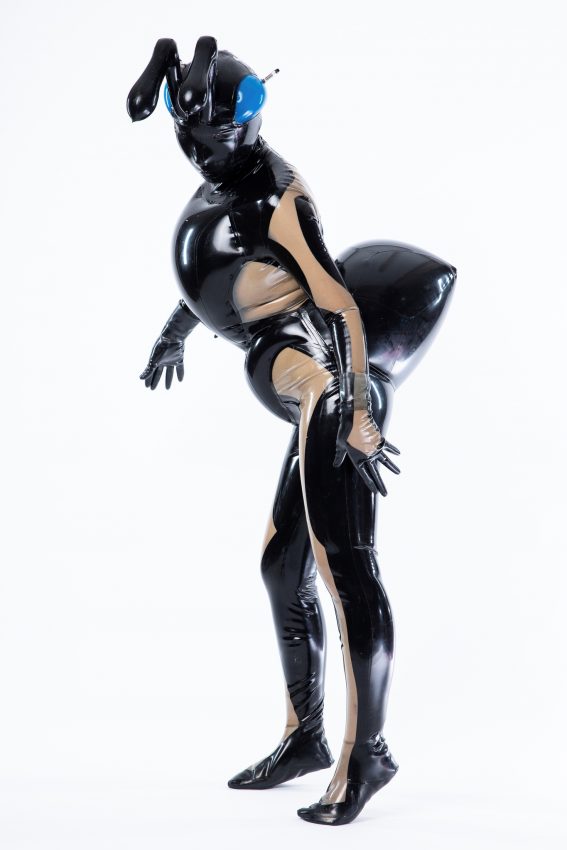
Photo: Taro Irei
10. Tapeworm (2023/VR Avatar)
A tapeworm that lives in an intestine. “The real ones don’t have eyes, but I used protrusions that they do have and designed them as eyes. Without them, they’re not cute enough. The body can be divided and can replicate itself, so I drew a face on each body segment to reflect that. In photos they look fake, but in the video when there was a whole bunch of them and they all swarmed togetherーit was really awesome.”
-
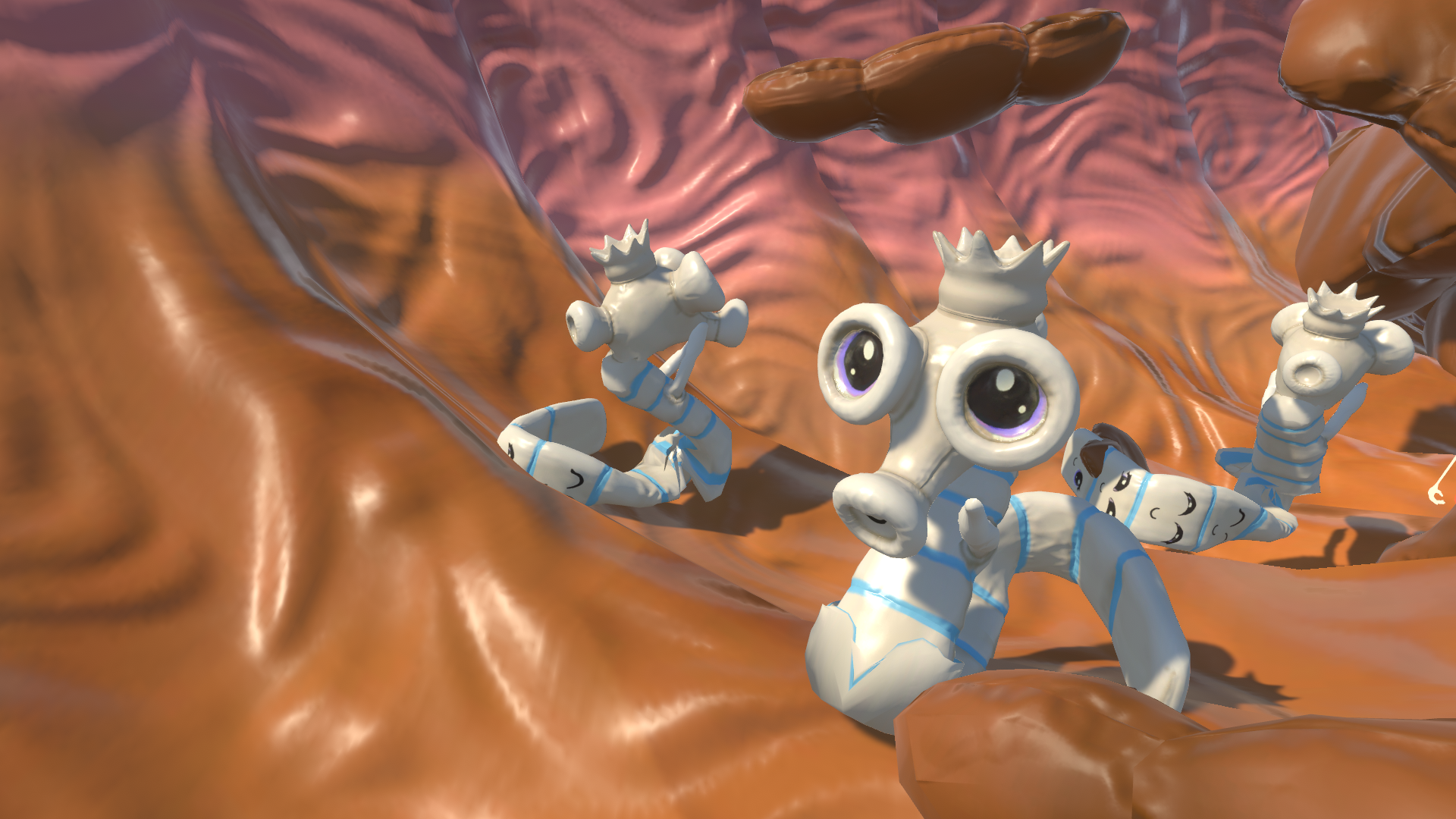
Photo: Yuki Homma
11. Saedog (2024/latex)
A weak dog. It seeks out the help of humans while also being fearful of them. “The design is a mixed-breed dog that fits well when there’s a human inside. I gave it this color because I wanted it to look pathetic when it limps along, yet noble at the same time. It’s weak, but it can also be giving, as a spiritual dog. According to her ‘internal organs’, Tae Tsuyuki, there were some children who named the Taedog, and there were other special relationships it made.”
-
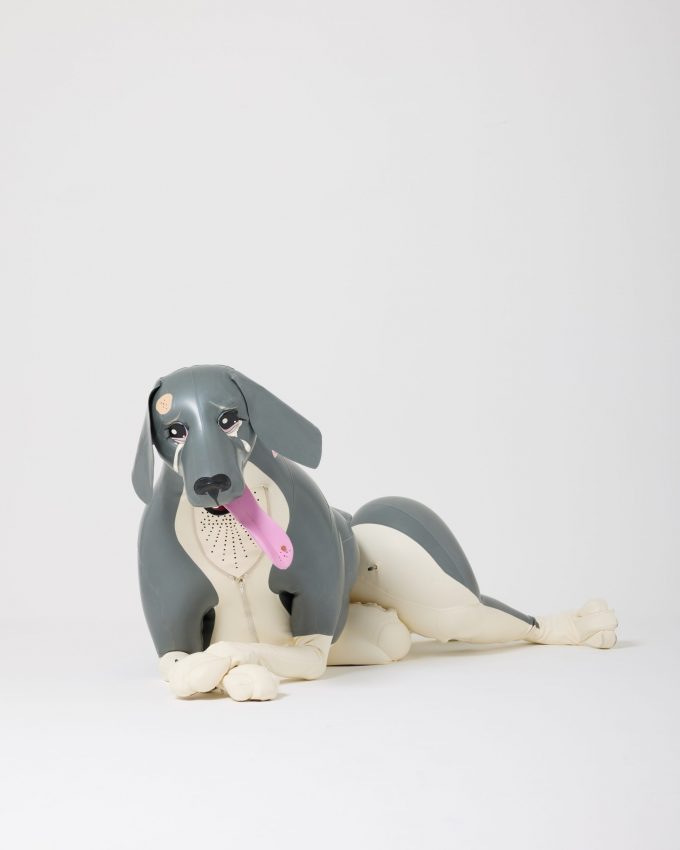
Photo: TAKAHASHI Kenji
12. Trees (2024/latex)
“I love the role of tree that you see in school plays. I actually wanted to make wearable trees, but then I would have needed multiple performers, and they would have had to stand for many hours, and I thought that would be too much to ask. That’s why they aren’t wearable. The background trees became part of the backdrop. It’s made to be like an old movie, like The Wizard of Oz. Like a small courtyard garden, it feels like I’ve made it like a little playtime corner. When children play with toys, they don’t demand consistency in their worldbuilding. I wanted to learn that sort of freedom from them.”
-
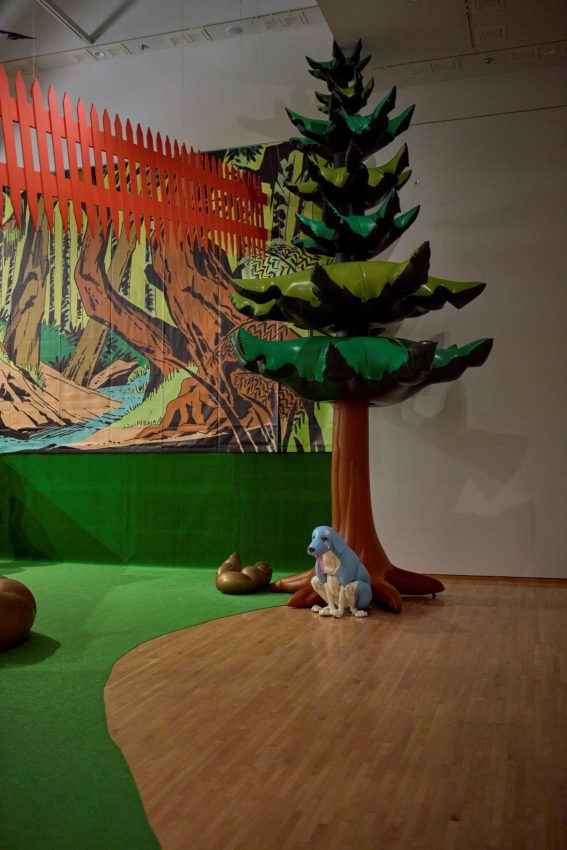
Photo: TAKAHASHI Kenji
13. Sun (2014/latex)
“I wanted to make a dance club event-style platform in the back of the farm and have a wearable glowing go-go dancer sun, but it’s too much work to build a platform, so I gave up on the wearable sun. To make up for it, later I made a glowing suit that looks like it’s on fire.
-
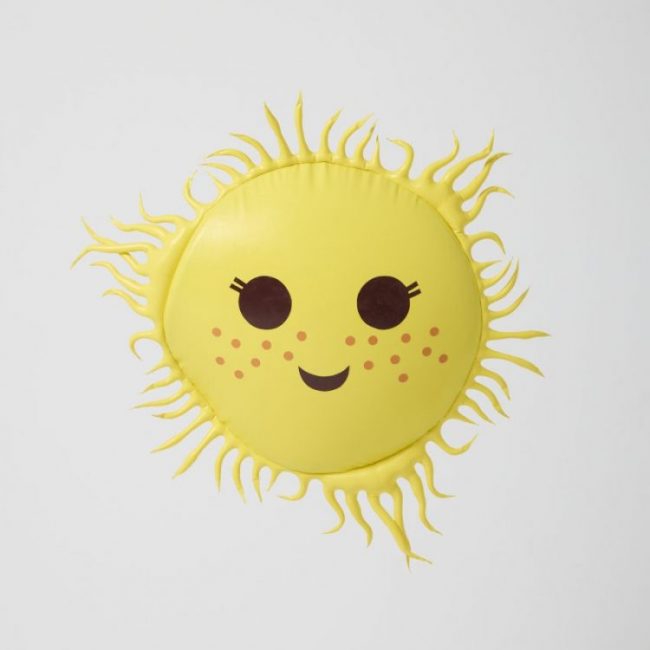
Photo: TAKAHASHI Kenji
Exhibition Inforation
Kurobe City Museum 30th Anniversary Saeborg Enchanted Animals
November 16, 2024 – January 13, 2025.
Details: https://kurobe-city-art-museum.jp/2024/08/07/saeborg/
-
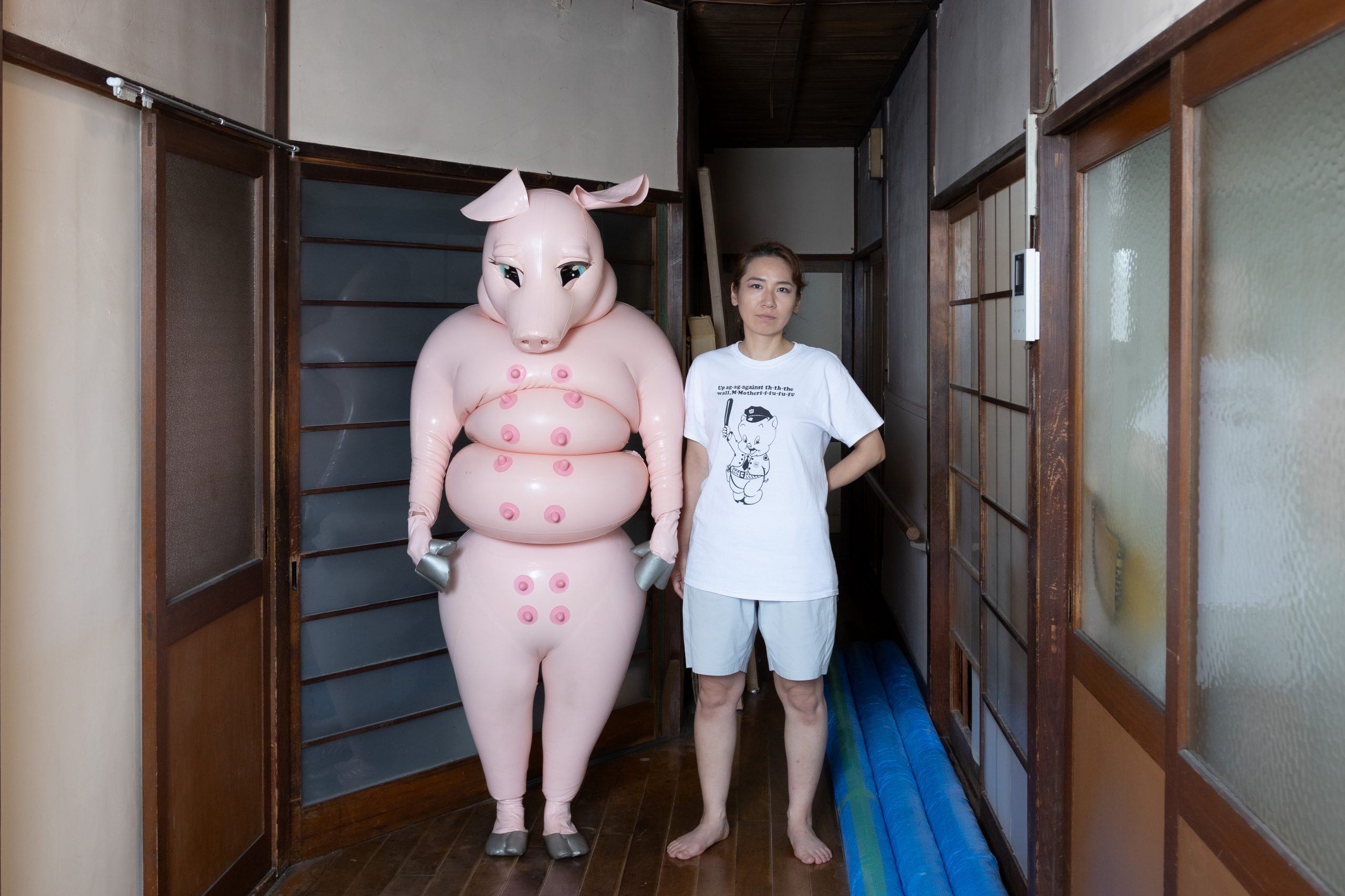
Photo: Kikuko Usuyama
Special thanks to Tae Tsuyuki
Related Tags





